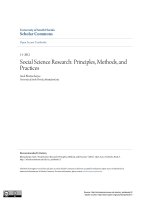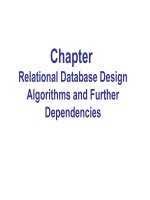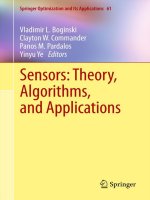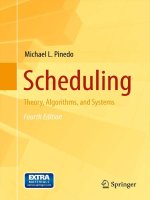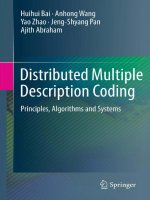distributed multiple description coding principles, algorithms and systems
Bạn đang xem bản rút gọn của tài liệu. Xem và tải ngay bản đầy đủ của tài liệu tại đây (4.11 MB, 185 trang )
Distributed Multiple Description Coding
Huihui Bai • Anhong Wang • Yao Zhao
Jeng-Shyang Pan • Ajith Abraham
Distributed Multiple
Description Coding
Principles, Algorithms and Systems
123
Dr. Huihui Bai
Institute of Information Science
Beijing Jiaotong University
Beijing 100044
China, People’s Republic
Prof. Yao Zhao
Institute of Information Science
Beijing Jiaotong University
Beijing 100044
China, People’s Republic
Prof. (Dr.) Ajith Abraham
Director – Machine Intelligence Research
Labs (MIR Labs)
Scientific Network for Innovation
and Research Excellence
P.O. Box 2259 Auburn, Washington 98071,
USA
Prof. Anhong Wang
Taiyuan University of Science
and Technology
Taiyuan 030024
China, People’s Republic
wah
Prof. Jeng-Shyang Pan
Department of Electronic Engineering
Nat. Kaohsiung University of Applied
Sciences
Chien-Kung Road 415
80778 Kaohsiung
Taiwan R.O.C.
ISBN 978-1-4471-2247-0 e-ISBN 978-1-4471-2248-7
DOI 10.1007/978-1-4471-2248-7
Springer London Dordrecht Heidelberg New York
British Library Cataloguing in Publication Data
A catalogue record for this book is available from the British Library
Library of Congress Control Number: 2011940972
© Springer-Verlag London Limited 2011
Apart from any fair dealing for the purposes of research or private study, or criticism or review, as
permitted under the Copyright, Designs and Patents Act 1988, this publication may only be reproduced,
stored or transmitted, in any form or by any means, with the prior permission in writing of the publishers,
or in the case of reprographic reproduction in accordance with the terms of licenses issued by the
Copyright Licensing Agency. Enquiries concerning reproduction outside those terms should be sent to
the publishers.
The use of registered names, trademarks, etc., in this publication does not imply, even in the absence of a
specific statement, that such names are exempt from the relevant laws and regulations and therefore free
for general use.
The publisher makes no representation, express or implied, with regard to the accuracy of the information
contained in this book and cannot accept any legal responsibility or liability for any errors or omissions
that may be made.
Printed on acid-free paper
Springer is part of Springer Science+Business Media (www.springer.com)
Preface
In the past decade or so, there have been fascinating developments in image
and video compression. The establishment of many international standards by
ISO/MPEG and ITU-T laid the common groundwork for different vendors and
content providers. The explosive growth of the network, multimedia, and wireless
is fundamentally changing the way people communicate with each other. Real-time
reliable transmission of image and video has become an inevitable demand. As we
all know, due to bandwidth and time limitation, highly efficient compression must be
applied to the original data. However, lower ability of wireless terminals, network
congestion, as well as network heterogeneity have posed great challenges on the
conventional image and video compression coding.
To address the problems, two novel techniques, distributed video coding (DVC)
and multiple description coding (MDC), are illustrated in this book. DVC can
effectively reduce the complexity of conventional encoders, so as to meet the lower
capacity of wireless terminals, and MDC can realize the reliable transmission over
error-prone channels.
This book is dedicated for addressing the DVC and MDC issues in a systematic
way. After giving a state-of-the-art survey, we propose some novel DVC and MDC
improvements for image and video transmission, with an attempt to achieve better
performance. For each DVC and MDC approach, the main idea and corresponding
algorithms design are elaborated in detail.
This book covers the fundamental concepts and the core technologies of DVC
and MDC, especially its latest developments. Each chapter is presented in a self-
sufficient and independent way so that the reader can select the chapters interesting
to them. The methodologies are described in detail so that the readers can repeat the
corresponding experiments easily.
For researchers, it would be a good book for inspiring new ideas about the novel
DVC and MDC technologies, and a quick way to learn new ideas from the current
status of DVC and MDC. For engineers, it would be a good guidebook to develop
practical applications for DVC and MDC system.
Chapter 1 provides a broad overview of DVC and MDC, from basic ideas
to the current research. Chapter 2 focuses on the principles of MDC, such as
v
vi Preface
sub-sampling based MDC, quantization based MDC, transform based MDC, and
FEC based MDC. Chapter 3 presents the principles of DVC, mainly including
Slepian-Wolf coding based on Turbo and LDPC respectively and comparing the
relative performance. Chapters 4 and 5 are devoted to the algorithms of MDC and
DVC, mainly focusing on the current research fruits of the authors. We provide the
basic frameworks and the experimental results, which may help the readers improve
the efficiency of MDC and DVC. Chapter 6 introduces the classical DVC system for
mobile communications, providing the developmental environment in detail.
This work was supported in part by Sino-Singapore JRP (No. 2010DFA11010),
National Natural Science Foundation of China (No. 61073142, No. 60903066,
No. 60972085), Beijing Natural Science Foundation (No. 4102049), Spe-
cialized Research Fund for the Doctoral Program of Higher Education
(No. 20090009120006), Doctor Startup Foundation of TYUST (20092011),
International Cooperative Program of Shanxi Province (No. 2011081055) and
The Shanxi Provincial Foundation for Leaders of Disciplines in Science (No.
20111022).
We are very much grateful to the Springer in-house editors, Simon Rees
(Associate Editor) and Wayne Wheeler (Senior Editor), for the editorial assistance
and excellent cooperative collaboration to produce this important scientific work.
We hope that the reader will share our excitement to present this book and will find
it useful.
Huihui Bai
Anhong Wang
Yao Zhao
Jeng-Shyang Pan
Ajith Abraham
Contents
1 Introduction 1
1.1 Background 1
1.2 Multiple Description Coding (MDC) 3
1.2.1 Basic Idea of MDC 3
1.2.2 Review of Multiple Description Coding 6
1.3 Distributed Video Coding (DVC) 7
1.3.1 Basic Idea of DVC 7
1.3.2 Review of DVC 9
References 13
2 Principles of MDC 19
2.1 Introduction 19
2.2 Relative Information Theory 20
2.2.1 The Traditional Rate-Distortion Function 20
2.2.2 The Rate-Distortion Function of MDC 21
2.3 Review of MDC 23
2.3.1 Subsampling-Based MDC 23
2.3.2 Quantization-Based MDC 24
2.3.3 Transform-Based MDC 26
2.3.4 FEC-Based MDC 28
2.4 Summary 28
References 29
3 Principles of DVC 31
3.1 Relative Information Theory 31
3.1.1 Independent Coding, Independent Decoding 31
3.1.2 Joint Coding, Joint Decoding 31
3.1.3 Independent Coding, Joint Decoding 32
3.1.4 Side Information Encoding in the Decoder 33
3.2 Distributed Source Coding 33
3.3 Turbo-Based Slepian–Wolf Coding 35
3.3.1 Problem Description 35
vii
viii Contents
3.3.2 Implementation Model 36
3.3.3 The Encoding Algorithm 36
3.3.4 RCPT Codec Principles 41
3.3.5 Experimental Results and Analysis 43
3.4 LDPC-Based Slepian–Wolf Coding 45
3.4.1 The Coding Theory of LDPC 45
3.4.2 The Implementation of LDPC Slepian–Wolf Encoder 46
3.4.3 The Coding and Decoding Algorithms of LDPCA
Slepian–Wolf 46
3.4.4 Experimental Results and Analysis 48
3.5 Summary 49
References 49
4 Algorithms of MD 51
4.1 Optimized MDLVQ for Wavelet Image 51
4.1.1 Motivation 51
4.1.2 Overview 52
4.1.3 Encoding and Decoding Optimization 56
4.1.4 Experimental Results 60
4.1.5 Summary 62
4.2 Shifted LVQ-Based MDC 62
4.2.1 Motivation 62
4.2.2 MDSLVQ 64
4.2.3 Progressive MDSLVQ Scheme 66
4.2.4 Experimental Results 69
4.2.5 Summary 73
4.3 Diversity-Based MDC 73
4.3.1 Motivation 73
4.3.2 Overview 74
4.3.3 Two-Stage Diversity-Based Scheme 76
4.3.4 Experimental Results 79
4.3.5 Summary 81
4.4 Steganography-Based MDC 82
4.4.1 Motivation 82
4.4.2 Basic Idea and Related Techniques 82
4.4.3 Proposed Two-Description Image Coding Scheme 84
4.4.4 Experimental Results 86
4.4.5 Summary 90
4.5 Adaptive Temporal Sampling Based MDC 90
4.5.1 Motivation 90
4.5.2 Proposed Scheme 91
4.5.3 Experimental Results 94
4.5.4 Summary 97
4.6 Priority Encoding Transmission Based MDC 98
4.6.1 Motivation 98
Contents ix
4.6.2 Overview 99
4.6.3 Design of Priority 102
4.6.4 Experimental Results 104
4.6.5 Summary 111
References 111
5 Algorithms of DVC 115
5.1 Wyner-Ziv Method in Pixel Domain 115
5.1.1 Motivation 115
5.1.2 Overview 116
5.1.3 The Proposed Coding Framework 116
5.1.4 Implementation Details 117
5.1.5 Experimental Results 119
5.1.6 Summary 119
5.2 Wyner-Ziv Method in Wavelet Domain 119
5.2.1 Motivation 119
5.2.2 Overview 121
5.2.3 The Proposed Coding Framework 122
5.2.4 Experimental Results 126
5.2.5 Summary 126
5.3 Residual DVC Based on LQR Hash 128
5.3.1 Motivation 128
5.3.2 The Proposed Coding Framework 129
5.3.3 Experimental Results 131
5.3.4 Summary 132
5.4 Hybrid DVC 134
5.4.1 Motivation 134
5.4.2 The Proposed Coding Framework 136
5.4.3 Experimental Results 140
5.4.4 Summary 140
5.5 Scalable DVC Based on Block SW-SPIHT 142
5.5.1 Motivation 142
5.5.2 Overview 143
5.5.3 The Proposed Coding Scheme 143
5.5.4 The Efficient Block SW-SPIHT 144
5.5.5 BMS with Rate-Variable “Hash” at Decoder 145
5.5.6 Experimental Results 146
5.5.7 Summary 148
5.6 Robust DVC Based on Zero-Padding 149
5.6.1 Motivation 149
5.6.2 Overview 150
5.6.3 Hybrid DVC 151
5.6.4 Pre-/Post-processing with Optimized Zero-Padding 153
5.6.5 Experimental Results 154
5.6.6 Summary 162
References 162
x Contents
6 DVC-Based Mobile Communication System 165
6.1 System Framework 165
6.2 Development Environment 165
6.2.1 Hardware Environment 165
6.2.2 Software Environment 167
6.2.3 Network Environment 167
6.3 Experimental Results 170
6.4 Summary 170
References 171
Index 173
Chapter 1
Introduction
1.1 Background
In home theater, VCD, DVD, and other multimedia applications and visual com-
munications such as video phone and video conference, how to effectively reduce
the amount of data and the occupied frequency band is an important issue necessary
to be solved. Among these application cases, image and video occupy the most
amounts of data; therefore, how to use as little data as possible to represent the
image and video without distortion has become the key to these applications, which
is the main issue of image and video compression.
Research on image compression has been done during the last several years.
Researchers have proposed various compression methods such as DPCM, DCT,
VQ, ISO/IEC, and ITU-T, and other international organizations have made many
successful image and video standards [1–8], such as the still image video standard
represented by JPEG and JPEG-2000, the coding standard of high-rate multimedia
data represented by MPEG-1 and MPEG-2 whose main content is video image
compression standard, the moving image compression standard of low bit rate, very
low bit rate represented by H.261, H.263, H.263C, H.263CC, H.264/AVC, as well
as the MPEG-4 standard of object-oriented applications.
In recent years, with the popularization and promotion of the Internet and
personal radio communication equipments, it has become an inevitable demand to
transmit image and video at real time in packet-switching networks and narrow-
band networks. Meanwhile, the low computing power of wireless multimedia
terminal equipment and the increasingly serious congestion problem in wireless
communication networks and the Internet, along with the growing complexity of
heterogeneity in networks, have brought great challenges to the traditional video
image coding.
From the perspective of the network device context, on the one hand, current
network communication involves a large number of mobile video intake equip-
ments, such as mobile camera phones, large-scale sensor network, video monitoring
on network, and so on. All these equipments possess the intake functions of
H. Bai et al., Distributed Multiple Description Coding,
DOI 10.1007/978-1-4471-2248-7 1, © Springer-Verlag London Limited 2011
1
2 1 Introduction
image and video, which are needed to conduct on-site video coding and transmit
the stream into center node, decoding, and playing. These devices are relatively
simple, and the operational ability and power itself is very limited. There exist
significant differences between the aspects of power display processing capabilities
and memory support hardware and traditional computing equipments that are far
from being able to meet the high complexity of motion estimation and other
algorithms in traditional video coding, but in the decoding end (such as base stations,
center nodes) have more computing resources and are able to conduct complex
calculations, contrary to application occasions of the traditional video coding. On
the other hand, there exist problems of channel interference, network congestion,
and routing delay in the Internet network that will lead to data error and packet loss,
while the random bit error and unexpected error and other problems in wireless
communication network channel further worsen the channel status, making for a
large number of fields of transmitted video data failure or loss. These problems
are fatal to data compression because the compressed data are generally the stream
consisting of unequally long codes, which will cause error diffusion and other
issues. If there is an error or data packet loss, this will not only affect the service
quality of video business but also cause the entire video communication system to
completely fail and become the bottleneck of restrictions on the development of
real-time network video technology.
From the perspective of video coding, the traditional video coding method, such
as MPEG, H.26X series standard, as a result of using motion estimation, motion
compensation, orthogonal transformation, scalar quantization, and entropy coding
in the coding end, causes higher computational complexity. Motion estimation is
the principle mean to remove the correlation between the video frames, but at the
same time, it is a most complex operation, because every coding block must do
similarity calculations with every block of the reference picture. Comparatively
speaking, in the decoding end, without the search operation of motion estimation, its
complexity is five to ten times easier than the coding end. Therefore, the traditional
video coding method is applied in situations when the coding end has stronger
computational capabilities or the one-time compression and multiple decoding of
non-real time, such as broadcasting, streaming media VOD services, and so on.
On the other hand, the traditional video coding focused more upon improving
the compressive properties, when data transformation error occurred, is mainly
dependent on the correcting capacity of post-channel coding. The international
video coding standard set recently, such as the Fine Granularity Scalability in
MPEG-4 [9] and the Progressive Fine Granularity Scalability with higher quality
proposed by Wu Feng [10], also tries to adopt a new coding frame to better adapt
to the network transmission. In FGS coding, in order to ensure the reliability of
transmission, the basic layer adopts stronger error protection measures such as the
stronger FEC and ARQ. But the following problems exist in this method: firstly,
the system quality will seriously decline when the network packet loss is serious;
in addition, repeat ARQ will cause excessive delay; and strong FEC will also bring
additional delay because of its complexity, seriously affecting the real-time play of
the video.
1.2 Multiple Description Coding (MDC) 3
All in all, in order to provide high-quality video services to the users in wireless
mobile terminals, we must overcome the low operational ability in the terminal and
the problem caused by unreliable transmission in the existing network; therefore,
we should design video coding which has low coding complexity and strong error-
resilient ability.
1.2 Multiple Description Coding (MDC)
1.2.1 Basic Idea of MDC
The basic idea of multiple description coding (MDC) is to encode the source into
many descriptions (bit stream) of equal importance and transfer them on non-
priority and unreliable networks. At the receiving end, receiving any description
can restore rough but acceptable approximation compared to the original coded
image. With the increasing number of the received descriptions, the precision of
reconstructed quality will gradually improve, thus, effectively solving the problem
of serious decline in quality when the traditional source encoding encounters packet
loss and delay on unreliable network.
Each description generated by the multiple description coding has the following
characteristics: Firstly, the importance of each description is the same and does not
need to design network priority specially, thus reducing the cost and complexity
of the network design. Secondly, every description being independent, the decoder
end can decode independently when receiving any description and reconstruct the
sources with acceptable quality. Thirdly, all descriptions have dependency, that is,
apart from the important information of one’s own, every description also includes
redundant information that helps to restore other descriptions. Therefore, the results
of decoding reconstruction will improve with the increasing number of received
descriptions. If every description can be received accurately, we can get high-quality
reconstruction signals in the decoder end [11].
The most typical multiple description encoder model encodes a source into
two descriptions, S
1
and S
2,
and transmits in two separate channels. As Fig. 1.1
illustrates, an MDC model possesses two channels and three decoders. In the
decoder end, if we only receive the description of channel 1 or channel 2, then we
can get the acceptable single road reconstruction through the corresponding single
channel decoder 1 or 2. The distortion caused by this is recorded as single channel
distortion D
1
or D
2
; if the descriptions of two channels can be received accurately,
then through the center of the decoder, we can get reconstruction of high quality. The
distortion caused by the two-way reconstruction is called center distortion, known
as D
0
. The rate of transmission in channel 1 or channel 2 is the required bit number
for each pixel of source.
Figure 1.2 shows the comparison of nonprogressive and progressive coding and
multiple description coding under retransmission mechanism. In the three cases,
the images are all transmitted by the six packets, but in the process of transfer, the
4 1 Introduction
Fig. 1.1 MDC model with two channels and three decoders
third packet is lost. As evident, when receiving the first two packets, nonprogressive
coding can only restore some of the image information, progressive coding and
multiple description coding can restore comparative fuzzy image information, and
the reconstruction effect of progressive coding is better than multiple description
coding. When the third data packet is lost, the image quality of nonprogressive
coding and progressive coding comes to a standstill, the main reason being that
these two schemes must base on the former data packet to decode the present
one; therefore, the data packets we receive after the loss of the third one have no
effect. We must wait for the successfully retransmission of the third one; however,
the retransmission time is usually longer than the interval of data packets, thus
causing unnecessary delay. However, using multiple description coding technology
is not affected by the loss of the third packet at all; the image quality is constantly
improving as the packets arrive one by one. From the time when the packet is
lost to its successful retransmit, the image quality of multiple description coding
is undoubtedly the best. Thus, it can be seen that when packet loss occurs, we can
use multiple description coding to transfer acceptable image for users faster.
We can see that multiple description coding is mainly used for loss compression
and transmission of signals; that is, data may be lost during the transfer process. The
restored signals allow a certain degree of distortion, for example, the compressing
and transfer of image, audio, video, and other signals. The occasions for application
are mainly as follows.
1.2.1.1 Internet Communication
Since the MDC has the characteristic of transfer on unreliable signal channel, it
has a wide application in the case of packet-switching networks. The Internet is
1.2 Multiple Description Coding (MDC) 5
Fig. 1.2 Comparison between nonprogressive/progressive coding with MDC [11]
6 1 Introduction
usually affected by network congestion, backbone network capacity, bandwidth,
and route selecting, which result in loss of data packets. The traditional solution is
ARQ; however, this method needs feedback mechanism and will further aggravate
congestion and delay, so it is not conducive to the application of real-time demand.
In addition, the existing layered coding requires the network to have priority and
have the ability to treat the data packets differently, thus increasing the complexity
of network design. But using MDC helps avoid these situations.
1.2.1.2 Partition Storage System
As for large image databases, adopt MDC to copy and store the image in different
positions, so that when fast browsing, we can quickly find a copy of low quality
stored in the nearest region; if we need an image of higher quality, we can search
one or several image copies stored in further areas and combine it with the copy of
the nearest area to improve the reconstruct quality of the image, and thus meet the
needs of various applications.
1.2.1.3 Wireless Communication
Because of channel fading, wireless communication often causes longer unexpected
bit error; the solution is to divide the signal channel into several virtual ones, such
as frequency hopping system is quite fit for MDC technology. In addition, the MDC
technology is also effective in solving the adjacent channel interference problem of
the wireless broadcasting system.
1.2.2 Review of Multiple Description Coding
The history of MDC can be traced back to the 1970s, when Bell Laboratories carried
out odd and even separation of the signal from the same call and transferred it in
two separate channels in order to provide continuous telephone service in telephone
networks [12]. At that time, the problem was called channel splitting by Bell
Laboratories. The MDC was formally put forward in September 1979, on Shannon
Theory Research Conference, at which time Gersho, Ozarow, Witsenhausen, Wolf,
Wyner, and Ziv made the following issues: if a source is described by two separate
descriptions, how will the reconstruct quality of signal source be affected when the
descriptions are separated or combined? The problem is called multiple description
problem. In this field, the original basic theory was put forward by the abovemen-
tioned researchers and Ahlswede, Berger, Cover, Gamal, and Zhang in the 1980s.
Earlier studies mainly focused on five elements function .R
1
;R
2
;D
0
;D
1
;D
2
/
produced by MDC, which has two channels and three decoders. At the conference
on Shannon theory research in September 1979, Wyner, Witsenhausen, Wolf, and
1.3 Distributed Video Coding (DVC) 7
Ziv gave the preliminary conclusions of MDC when dual source under the Hamming
distortion. For any zero memory information source and the given distortion vector
under bounded distortion .D
0
;D
1
;D
2
/, Gamal and Cover gave the reachable rate
area .R
1
;R
2
/ [13]. Ozarow proved that the above areas were tight to non-memory
Gaussian source and square error [14]. Then Ahlswede pointed out that when there
is no residual rate, that is, R
1
CR
2
D R.D
0
/, the above Gamal-Cover limit was tight
[15]. Zhang and Bergner proved that if D
0
>D.R
1
C R
2
/, the above boundaries
were not tight [16]. The above conclusions were studied on Gaussian information
source, yet we do not fully know the rate-distortion boundaries of non-Gaussian
information sources. Zimir studied on MDC under mean square error of non-discrete
and zero memory information sources. Given the scope of rate distortion, in fact, it
is the extension of Shannon boundary under rate-distortion function [17]. As to the
research on the reachable region of five elements function .R
1
;R
2
;D
0
;D
1
;D
2
/,
the main task was concentrated on non-memory binary symmetric source under
Hamming distortion.
In the early stage, the MDC mainly conducted theoretical studies. After Vaisham-
payan gave the first practical MDC method, multiple description scalar quantization
[18], research on MDC changed from theoretical investigation to the construction
of practical MDC system. Around 1998, MDC became the research hotspot for
many scholars; many new MDC methods emerged, such as the MDC based on
subsampling, MDC based on quantization, transform-based MDC, and so on. In
Chapter 2 we will introduce these in detail.
The national multiple description video coding began in 1990. Some of the
existing MDC are encoding schemes of block-based motion estimation and motion
compensation; this will inevitably involve the problem of mismatch correction,
that is, how to deal with the problem of inconsistent frame in codec caused by
signal channel error [19]. In addition, MDC must consider the issue of non-real
multiple description signal channel. Some existing MDC methods were put forward
in the hypothesis of the ideal multiple description signal channel; the descriptions
transmitted in an ideal signal channel can be all received correctly or lost. But in
fact, both the Internet and the wireless channel are not ideal description channels;
the packet may be lost randomly in any channel. Therefore, the multiple description
video coding scheme should also consider the effect of multiple description channel
to the video reconstruct quality.
1.3 Distributed Video Coding (DVC)
1.3.1 Basic Idea of DVC
In order to solve the problem of high complexity in traditional video coding,
Distributed Source Coding (DSC) gets attention of more and more scholars.
DSC bases on the theory of source coding in the 1970s: theory of Slepian–Wolf
8 1 Introduction
Fig. 1.3 Classical framework of DVC
[20, 21] under lossless circumstance and theory of Wyner–Ziv [22–24] under
distortion circumstance, including the following Wyner–Ziv coding theory of
decoding side information [25, 26]; these theories abandon the traditional principle
that only the coding end can use the statistical characteristic of signal sources and
propose that we can also achieve effective compression in the decoding end by using
the statistical characteristic of signal.
Distributed Video Coding (DVC) [27] is the successful application of DSC theory
in video compression; its basic idea is regarding the adjacent frames of the video
as related source and adopting the coding frame of “independent coding and joint
decoding” for adjacent frames, which has essential difference with the structure of
“joint coding and joint decoding” for adjacent frames in traditional video coding
standard MPEG. The typical DVC, as shown in Fig. 1.3, extracts a group of frames
with equal interval from the image sequence to code which are called key frames;
its coding and decoding adopt the traditional intra ways, such as H.264 coding
technology. The frames between the key frames are called WZ frames; these frames
adopt the coding method of intra coding and inter decoding. Because WZ coding
transfers some or all of the motion estimation of huge amount of calculation in tra-
ditional video coding algorithm to the decoding end, DVC realizes low-complexity
encoding. In addition, in WZ encoder, the Slepian–Wolf encoder is created by
channel codes, and its decoding end adopts error-correcting algorithm of channel
codes. When the error-correcting ability of channel code is strong, even if error
occurs during the transmission of WZ code stream, it can be corrected. Therefore,
DVC has a certain robustness of channel transmission, which is because of low-
complexity coding. DVC is particularly suitable for the transmission requirement of
the emerging low power consumption network terminal.
Figure 1.4 illustrates an example of the application of DVC in the low power
consumption mobile phone communication which adopts the method of transcoding
to realize video communication between two mobile phones with low operational
ability. Take the communication from A to B as an example – A is compressed
1.3 Distributed Video Coding (DVC) 9
Fig. 1.4 Transcoding architecture for wireless video
by the DVC method of low complexity coding – then transmit the compressed bit
stream to mobile network base station which can change the distributed video stream
into MPEG stream and then transfer the stream to mobile phone B; it can get the
restored video by using MPEG decoding algorithm of lower complexity. This kind
of communication mode integrates the advantage of coding method of DVC and
traditional MPEG; the mobile terminal only needs simple calculation, and a large
number of calculations focus on a specific device in network, thus satisfying the
“‘low-complexity encoding’ demand of low energy consumption devices.”
However, DVC as a new coding framework different from traditional encoding,
there is still much room for improvements such as compressive properties, robust-
ness of adapting to network transmission, and scalability, etc.; the following sections
will analyze its research status and disadvantages from various aspects.
1.3.2 Review of DVC
Analyzing the coding framework of Fig. 1.3 again, generally speaking, WZ encoder
consists of quantizer and a Slepain–Wolf encoder based on channel code, for X – the
input of WZ (also called main information), DVC can be divided into two schemes –
pixel domain and transform domain; the former directly uses WZ encoding for the
pixel of WZ frame, while the latter first transforms WZ frame and then compresses
the transform coefficients by WZ encoder. Girod of Stanford University in the
USA realized the DVC in pixel domain earlier [28–30], adopted uniform scalar
quantization for every pixel, and compressed the quantized sequence by Slepian–
Wolf encoder based on Turbo code. WZ encoding in the pixel domain has obtained
the rate distortion performance between the traditional intra coding and inter coding,
10 1 Introduction
and then the Girod task group applied the DCT transformation into DVC and
proposed DVC in DCT domain based on Turbo code [31, 32]. Ramchandran [33–
35] also proposed the scheme of DVC in DCT domain, that is, the scheme of
power-efficient, robust, high compression, and syndrome-based multimedia coding;
they do scalar quantization for DCT transform coefficients of 8 8andcompress
the quantized DCT coefficients by trellis code. Because transform coding further
removed the space redundancy of the image, the effect of DVC in DCT domain
is better than that in pixel domain. On the basis of the above proposed scheme,
someone proposed some improved algorithm to develop the performance of DVC,
such as PRISM in wavelet domain [36], a series of algorithms based on Girod
framework proposed by the organization DISCOVER in Europe [37, 38].
However, the current research results show that the performance of DVC is
between the traditional intra coding and inter coding; it still has a large gap
compared with the traditional intra video coding standard and, therefore, how to
improve the compressive properties of DVC is one of the current research topics,
followed by analysis according to the various modules of DVC framework.
First of all, in the aspects of quantization module design, the quantizer in WZ
encoder conducts certain compression for the signal source and at the same time
represents the signal source as an index sequence to facilitate the decoding end
to do index resumed by using side information. For easy implementation, almost
every DVC adopts uniform scalar quantization; for example, the DVC in pixel
domain applies SQ directly into various pixels, DVC in DCT domain applies the
scalar quantization into DCT coefficients, etc., but the performance of simple scalar
quantization is not satisfying. Some documents do theory and application research
on the quantizer in WZ encoding. Zamir and Shamai proved that when the signal-
to-noise is high, when the main information and side information are joint Gaussian
source, then the nested liner lattice quantization can approach WZ rate distortion
function, so [39, 40] made the enlightenment design scheme while Xiong et al. [41]
and Liu et al. [42] proposed a nested lattice quantization and Slepian–Wolf encoder,
then applied the scheme of the combination of trellis [43] and lattice. On the issue
of DSC quantizer optimization, Fleming et al. [44] consider using Lloyd algorithm
[45] to get the locally optimal WZ vector quantization to realize the optimization
of fixed rate. Fleming and Effros [46] adopted the rate-distortion optimized vector
quantization, regarding the bit rate as quantization index function, but the efficiency
of the scheme is low and complex. Muresan and Effros [47] implemented the
problem of looking for local optimum quantization from the adjacent regions. In
[48] they illustrated the scheme of [47] and restricted its global optimization due to
the adjacent codeword. In [49], authors considered applying the Lloyd to Slepian–
Wolf encoding without side information. The Girod task group applied the method
of Lloyd into the general ideal Slepian–Wolf encoder whose bit rate depends on
the index and side information of the quantizer; Rebollo-Monedero et al. [50]
illustrated that when the bit rate is high, and under certain constraints, the most
optimized quantizer is lattice quantizer, and also verified the experimental results
of [51]. In addition, Tang et al. [52] proposed the application of wavelet transform
and embedded SPIHT quantization method into multispectral image compression.
1.3 Distributed Video Coding (DVC) 11
In short, the pursuit of simple, practical, and optimized transform and quantification
method is a key to improve the performance of DVC.
Secondly, in terms of Slepian–Wolf encoder module, many researchers put
forward a number of improved methods. Slepian–Wolf encoder is another key
technology of DVC. Although the theories in 1970s have indicated that Slepian–
Wolf encoding and channel coding are closely related, in recent years the emergence
of high-performance channel code, such as Turbo code and LDPC code, has led to
the gradual appearance of some practical Slepian–Wolf encoders. In 1999, Pradhan
and Ramchandran proposed the use of the trellis [39, 53–56] as Slepian–Wolf
encoder, later Wang and Orchard [57] proposed the embedded trellis Slepian–
Wolf encoder; since then, channel coding technology of higher performance was
applied to DSC, such as the compression scheme based on Turbo code [58–65].
Later research found that the Slepian–Wolf based on low density parity check is
closer to the ideal limit. Schonberg et al., Leveris et al., and Varodayan et al. [66–
68] compressed the binary sources by LDPC encoder, and from then on, it raised
people’s research interest and widespread attention. The difference between the bit
rate of Slepian–Wolf encoder and the ideal Slepian–Wolf limit reflects the quality
of its performance; the distance between the most common Turbo code Slepian–
Wolf encoder and the ideal limit is 3–11% [59], while the distance between the
LDPC-based Slepian–Wolf encoder and ideal limit is still 5–10% [68]. The gap
is large when the correlation between primary information and side information is
low and the code length is short; therefore, pursuing a higher compression rate while
reducing the gap with Slepian–Wolf limit is a research goal of Slepian–Wolf encoder
for a long time.
In addition, the realization of bit rate adaptive control is also a key issue for the
practical of Slepian–Wolf encoder; the effect of Slepian–Wolf encoder to DVC is
similar to that of entropy encoding to traditional coding, but in traditional coding,
because the coding end knows the statistical correlation of the source, it can send
bits correctly according to the correlation and achieve lossless recovery. However, in
DVC, because the coding end does not know the correlation of the side information,
it cannot know the number of the required bits for lossless recovery of the decoding
end, causing the blind rate control. At present, we often use decoding end and
feedback channel to achieve rate adaptive of DVC, such as the Girod scheme and
so on, but feedback brings about limitations to practical application. The scheme
of PRISM proposed that conducting simple estimation for time correlation in the
coding end to send the syndrome, although the proposal does not use the feedback,
leads to the incorrectness of the syndrome bit due to the gap of correlation between
the coding end and decoding end. The later documents research on the problem
of how to remove the feedback channel; for example, Brites and Pereira [69]
suggest that by using the bit rate control in the coding end to remove feedback,
the rate distortion performance reduces about 1.2 dB compared with that of using
bit rate control in the decoding end. Tonomura et al. [70] proposed using the
cross-probability of bit plane to estimate the check bit to be sent by DVC and thus
remove the feedback channel. Bernardini et al. [71] put forward use of the fold
function to process the wavelet coefficients, take advantage of the periodicity of the
12 1 Introduction
fold function, the correlation of side information, to remove the feedback. Further,
Bernadini, Vitali et al. [72] use a Laplacian model to estimate the cross-probability
of primary information and side information after quantization, then according to
the cross-probability, send suitable WZ bit to remove the feedback channel. Moreby
et al. [73] put forward the no-feedback DVC scheme in pixel domain. Yaacoub et al.
[74] put forward the problem of adaptive bit allocation and variable parameters
quantization in multisensor DVC and according to the motion status of video and
the actual channel statistical characteristic to allocate rate.
The motion estimation in the coding end is an important factor for the success
of traditional video coding; in contrast, the existing DVC scheme moves the motion
estimation to the decoding end and uses the recovery frame in the decoding end
to motion estimate to produce side information. However, incorrect recovery frame
leads to incorrect motion estimation. This will cause the decrease in performance
of side information and eventually cause the decline in DVC performance; so
improving the performance of motion estimation is a critical part to improve DVC
performance. Motion estimation in DVC is first proposed by the group PRISM [33–
35]; they conduct cyclic redundancy check for the DCT block and send it to the
receiver by comparing the reference block and the present block of side information
to assist motion estimation, but the scheme is relatively complex. Girod of Stanford
[28–31] first used the motion estimation interpolation to produce side information,
but the performance of this method is lower because it does not use any information
of the current frame. In order to maintain the simple properties of the encoder and to
obtain the information of the current frame, in Aaron et al. [75]. Girod puts forward
a Hash-based motion estimation method; that is, the coding end adopts a subset of
the DCT quantization coefficients as the Hash and sends it to the decoding end,
based on the received Hash information, and conducts motion estimation in the
reference block of the decoding frame to get better side information. In fact, the
CRC of PRISM scheme also can be regarded as a kind of Hash information. On the
basis of Girod, Ascenso and Pereira [76] put forward the adaptive Hash; Martinian
et al. [77] and Wang et al. [78] put forward a low-quality reference Hash; that is, the
version of WZ frame is compressed by zero motion vector H.264. However, further
study is needed on the rate of Hash information, complexity, and its effectiveness
on motion estimation performance. Adikari et al. [79] put forward the generating
method of multiside information in the decoding end, but the complexity increased.
In addition, some papers suggest that the decoding end and coding end share the
motion estimation to improve the performance; for example, Sun and Tsai [80]used
optical flow estimation to get the motion status of the block in the encoding end;
the decoding end chose suitable generating method of side information based on
this status, but to a certain degree, these methods increased the complexity of the
encoding end.
Additionally, Ascenso et al. [37] put forward the gradually refined method
for side information in the decoding end; it does not need the extra Hash bit
and uses the information of the current frame which has been partially decoded
to update the side information gradually, so it is also a good way to improve
code performance. It is encouraging that Dempster et al. [81] used Expectation
References 13
Maximization to study the parallax of the current frame and other frames and formed
the so-called parallax unsupervised learning [82], and it provided a very good idea
for the improvement of side information performance. Some research works [83–
85] applied the unsupervised method for distributed multi-view video coding and
achieved very good results. In 2008, they applied this method for the generation
of side information in single viewpoint DVC [86], and the experimental results
show that the motion estimation in the decoding end based on EM provided very
good results and improved the performance of side information. The performance
of DVC improves with the increase of GOP, as per earlier studies, due to the poor
performance of side information, when the GOP is larger; the performance of DVC
becomes poor instead. Later, Chen et al. [87] applied the parallax-unsupervised
method and Gray coding and other technologies into the research of multi-view
DVC and achieved obvious effects.
In addition, the reference model of primary information and side information in
DSC and DVC affects the performance of Slepian–Wolf encoder to a great extent.
Bassi et al. [88] defined two practical relevance models as for Gaussian source.
Brites and Pereira [89] proposed different correlation models for primary informa-
tion and side information of different transform domains and put forward dynamic
on-line noise model to improve the correlation estimation. The representation of the
quantized primary information and side information will also affect the performance
of DVC to a great extent. Gray code can represent the value with smaller Euclidean
distance with smaller Hamming distance, so as to improve the correlation of
quantitative binary sequences, and ultimately improve the compression rate of the
Slepian–Wolf encoder. He et al. [90] proved the effectiveness of Gray code in DVC
with theory and experiments, and Hua and Chen [91] proposed using Gray code,
Zero-Skip, and the symbol of the coded DCT coefficients to effectively represent
the correlation and eventually improve the performance.
Finally, for the quantitative reconstruction of DVC, many papers use the condi-
tional expectation of quantified sequences in the given side information to carry out
reconstruction. Weerakkody et al. [92] refined the reconstruct function, especially
when the side information and the decoded quantitative value are not in the same
interval; we use training and regression method to get the regression line between
the bit error rate and reconstruct value, so as to improve the performance of
reconstruction.
References
1. JPEG Standard, JPEG ISO/IEC 10918–1 ITU-T Recommendation T.81
2. JPEG 2000 Image coding system, ISO/IEC International standard 15444–1, ITU Recommen-
dation T.800 (2000)
3. ISO/IEC. JCT1/SC29 CD11172–2 MPEG1. International standard for coding of moving
pictures and associated audio for digital storage media at up to 1.5 Mbps (1991)
4. ISO/IEC. JCT1/SC29 CD13818–2 MPEG2. Coding of moving pictures and associated audio
for digital storage (1993)
14 1 Introduction
5. ISO/IEC. JCT1/SC29 WG11/N3536 MPEG4. Overview V.15 (2000)
6. ITU-T Draft ITU-T Recommendation H.261: Video codec for audio/visual communications at
p 64 kbps (1993)
7. ITU-T Draft ITU-T Recommendation H.263 (V1, V2, V3): Video coding for low bit rate
communications (1996–2000)
8. JVT & ITU-T VCEG, Draft ITU-T Recommendation and final draft international standard of
joint video specification H.264 (MPEG-4 Part10)[S] (7–14 Mar 2003)
9. Radha, H.M., Schaar, M.V.D., Chen, Y.: The MPEG-4 fine-grained scalable video coding
method for multimedia stream over IP. IEEE Trans. Multimed. 3(3), 53–68 (2001)
10. Wu, F., Li, S., Zhang, Y.Q.: A framework for efficient progressive fine granularity scalable
video coding. IEEE Trans. Circuits Syst. Video Technol. 11(3), 332–344 (2001)
11. Goyal, V.K.: Multiple description coding: compression meets the network. IEEE Signal Proc.
Mag. 18(5), 74–93 (2001)
12. Jayant, N.S.: Subsampling of a DPCM speech channel to provide two ‘self-contained’ half-rate
channels. Bell Syst. Tech. J. 60(4), 501–509 (1981)
13. El Gamal, A.A., Cover, T.M.: Achievable rates for multiple descriptions. IEEE Trans. Inf.
Theory 28, 851–857 (1982)
14. Ozarow, L.: On a source-coding problem with two channels and three receivers. Bell Syst.
Tech. J. 59(10), 1909–1921 (1980)
15. Ahlswede, R.: The rate distortion region for multiple description without excess rate. IEEE
Trans. Inf. Theory 36(6), 721–726 (1985)
16. Lam, W. M., Reibman, A. R., Liu, B.: Recovery of lost or erroneously received motion vectors.
In: IEEE International Conference on Acoustics, Speech and Signal Processing, (ICASSP’93),
Minneapolis, vol. 5, pp. 417–420 (Apr 1993)
17. Zamir, R.: Gaussian codes and Shannon bounds for multiple descriptions. IEEE Trans. Inf.
Theory 45, 2629–2635 (1999)
18. Vaishanmpayan, V.A.: Design of multiple description scalar quantizers. IEEE Trans. Inf.
Theory 39(3), 821–834 (1993)
19. Wang, Y., Reibman, A.R., Lin, S.: Multiple description coding for video delivery. Proc. IEEE
93(1), 57–70 (2005)
20. Slepian, D., Wolf, J.K.: Noiseless coding of correlated information sources. IEEE Trans. Inf.
Theory 19(4), 471–480 (1973)
21. Wyner, A.D.: Recent results in the Shanno theory. IEEE Trans. Inf. Theory 20(1), 2–10 (1974)
22. Wyner, A., Ziv, J.: The rate-distortion function for source coding with side information at the
decoder. IEEE Trans. Inf. Theory 22(1), 1–10 (1976)
23. Wyner, A.D.: The rate-distortion function for source coding with side information at the
decoder-II: general source. Inf. Control 38(1), 60–80 (1978)
24. Wyner, A.: On source coding with side information at the decoder. IEEE Trans. Inf. Theory
21(3), 294–300 (1975)
25. Zamir, R.: The rate loss in the Wyner-Ziv problem. IEEE Trans. Inf. Theory 42(6), 2073–2084
(1996)
26. Zamir, R., Shamain, S.: Nested linear/lattice codes for Wyner-Ziv encoding. In: Proceedings of
Information Theory Workshop, Killarney, pp. 92–93 (1998)
27. Griod, B., Aaron, A., Rane, S.: Distributed video coding. Proc. IEEE 93(1), 71–83 (2005)
28. Aaron A., Zhang, R., Griod, B.: Wyner-Ziv coding of motion video. In: Proceedings of
Asilomar Conference on Signals and Systems, Pacific Grove (2002)
29. Aaron, A., Rane, S., Griod, B.: Toward practical Wyner-ziv coding of video. In: Proceedings
of IEEE International Conference on Image Proceeding, Barcelona, pp. 869–872 (2003)
30. Aaron A., Rane, S., Girod, B.: Wyner-Ziv coding for video: applications to compression and
error resilience. In: Proceedings of IEEE Data Compression Conference, Snowbird, pp. 93–102
(2003)
31. Aaron, A., Rane, S., Setton, E., Griod, B.: Transform-domain Wyner-Ziv codec for video. In:
Proceedings of Visual Communications and Image Processing, San Jose (2004)

